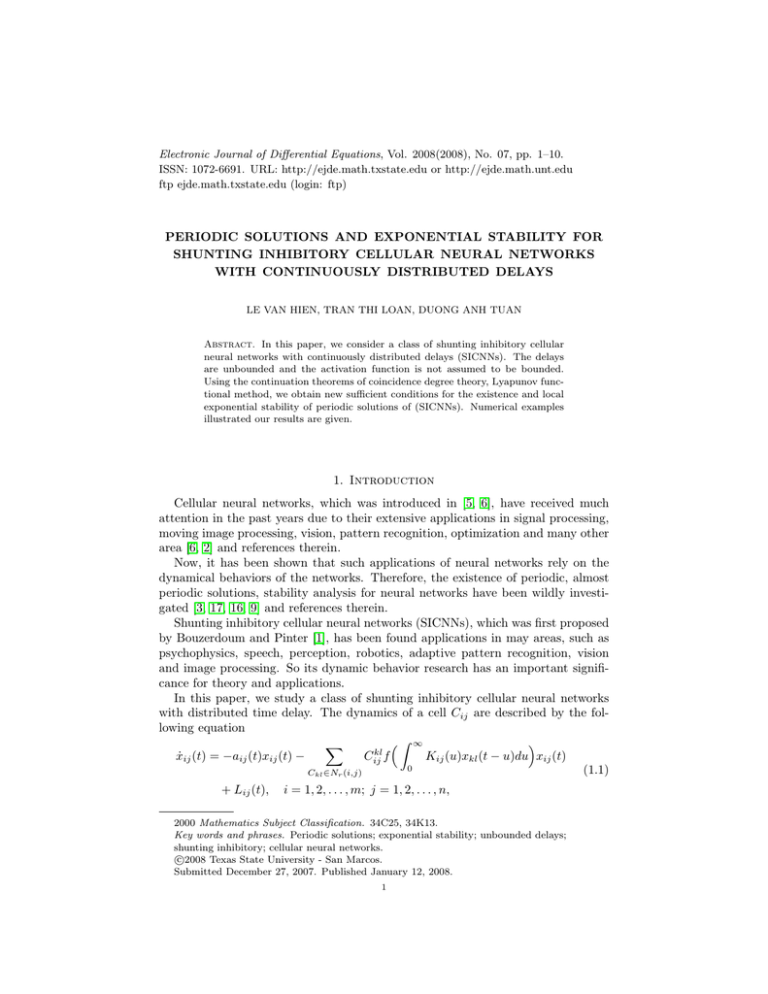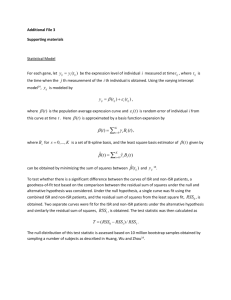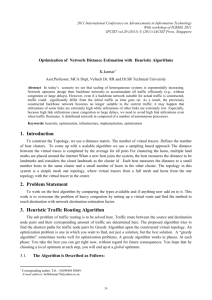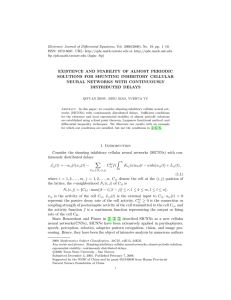Electronic Journal of Differential Equations, Vol. 2008(2008), No. 07, pp.... ISSN: 1072-6691. URL: or
advertisement

Electronic Journal of Differential Equations, Vol. 2008(2008), No. 07, pp. 1–10.
ISSN: 1072-6691. URL: http://ejde.math.txstate.edu or http://ejde.math.unt.edu
ftp ejde.math.txstate.edu (login: ftp)
PERIODIC SOLUTIONS AND EXPONENTIAL STABILITY FOR
SHUNTING INHIBITORY CELLULAR NEURAL NETWORKS
WITH CONTINUOUSLY DISTRIBUTED DELAYS
LE VAN HIEN, TRAN THI LOAN, DUONG ANH TUAN
Abstract. In this paper, we consider a class of shunting inhibitory cellular
neural networks with continuously distributed delays (SICNNs). The delays
are unbounded and the activation function is not assumed to be bounded.
Using the continuation theorems of coincidence degree theory, Lyapunov functional method, we obtain new sufficient conditions for the existence and local
exponential stability of periodic solutions of (SICNNs). Numerical examples
illustrated our results are given.
1. Introduction
Cellular neural networks, which was introduced in [5, 6], have received much
attention in the past years due to their extensive applications in signal processing,
moving image processing, vision, pattern recognition, optimization and many other
area [6, 2] and references therein.
Now, it has been shown that such applications of neural networks rely on the
dynamical behaviors of the networks. Therefore, the existence of periodic, almost
periodic solutions, stability analysis for neural networks have been wildly investigated [3, 17, 16, 9] and references therein.
Shunting inhibitory cellular neural networks (SICNNs), which was first proposed
by Bouzerdoum and Pinter [1], has been found applications in may areas, such as
psychophysics, speech, perception, robotics, adaptive pattern recognition, vision
and image processing. So its dynamic behavior research has an important significance for theory and applications.
In this paper, we study a class of shunting inhibitory cellular neural networks
with distributed time delay. The dynamics of a cell Cij are described by the following equation
Z ∞
X
kl
ẋij (t) = −aij (t)xij (t) −
Cij
f
Kij (u)xkl (t − u)du xij (t)
0
(1.1)
Ckl ∈Nr (i,j)
+ Lij (t),
i = 1, 2, . . . , m; j = 1, 2, . . . , n,
2000 Mathematics Subject Classification. 34C25, 34K13.
Key words and phrases. Periodic solutions; exponential stability; unbounded delays;
shunting inhibitory; cellular neural networks.
c
2008
Texas State University - San Marcos.
Submitted December 27, 2007. Published January 12, 2008.
1
2
L. V. HIEN, T. T. LOAN, D. A. TUAN
EJDE-2008/07
where Cij denote the cell at the (i, j) position of the lattice, the r-neighborhood
Nr (i, j) of Cij is determined by
Nr (i, j) = {Ckl : max(|k − i|, |l − j|) ≤ r, 1 ≤ k ≤ m, 1 ≤ 1 ≤ n}.
Here xij is the activity of the cell Cij , Lij is the external input to Cij , aij (t) > 0
kl
represent a passive decay rate of the cell activity, Cij
≥ 0 is the connection of
coupling strength of postsynaptic activity of the cell transmitted to the cell Cij ,
the activity function f is a positive continuous function, representing the output or
firing rate of cell Ckl .
Using Poincaré mapping, the authors in [4] proved the existence and global
exponential stability of periodic solutions. However, the activation function f (.)
was bounded, Lipschitzian and the time delay was finite.
In recent paper [17], with assumptions the activation function f (.) was Lipschitzian and f (0) = 0, the authors give conditions for the existence and stability
of almost periodic solutions of (1.1). However, we see that the conditions for the
stability depend on each solution of (1.1). So, it’s difficult for the stability test.
In this paper, by using coincidence degree theory, we prove the existence and
exponential stability of periodic solution of (1.1) without assumptions on boundedness and f (0) = 0 of activation function.
Denote by BC the BanachPspace of bounded continuous functions φ : (−∞, 0] →
Rmn with the norm kφk = ( i,j sup−∞<s≤0 |φij (s)|2 )1/2 .
The initial conditions associated with (1.1) are of the form
x(θ) = φ(θ),
θ ∈ (−∞, 0], φ ∈ BC.
(1.2)
For system (1.1) we consider the following hypotheses
(H1) RThe delay kernels Kij : [0, ∞) → R are piecewise continuous and Pij (ε) =
∞
Kij (u)eεu du is continuous on [0, δ), Pij (0) = 1 for some δ > 0.
0
(H2) The functions aij (t), Lij (t) are ω-periodic, f (.) is positive, continuous and
not assumed to be bounded on R.
Let Lij = supt∈R |Lij (t)|, aij = inf t∈R aij (t) > 0.
This paper is organized as follows. Section 2 presents notations, mathematical
definitions and some results from coincidence degree theory that needed to use in
the proof of main results in section 3. In section 3, we give new sufficient conditions
for the existence of periodic solutions of (SICNNs). Based on Lyapunov functional
method, the local exponential stability of the periodic solution of (SICNNs) is
established. An example illustrates our main results is given in section 4. The
paper ends with conclusion and cited references.
2. Preliminaries
In this section, we recall some notations and results in coincidence degree theory
that to be used in the proof of our main results.
Let X, Y be normed vector spaces, L : Dom L ⊂ X → Y be a linear operator and
N : X → Y be a continuous mapping. The mapping L will be called a Fredholm
mapping if
(a) Ker L is a finite dimensional subspace of X;
(b) Im L is closed;
(c) Im L has a finite co-dimension.
EJDE-2008/07
PERIODIC SOLUTION AND EXPONENTIAL STABILITY
3
When L is Fredholm mapping, its index is a integer defined by
Ind L := dim Ker L − codim Im L.
Suppose that L is Fredholm mapping of index zero, then there exist continuous
projectors P : X → Y and Q : Y → Y such that
Im P = Ker L, Ker Q = Im L = Im(I − Q).
: Dom L ∩ Ker P → Im L is invertible. DeIt follows that mapping LDom L∩Ker
P
noted by KP the inversion of LDom L∩Ker P .
Let Ω be an open and bounded subset of X, the mapping N is called L−compact
on Ω if QN (Ω) is bounded and KP (I − Q)N : Ω → X is compact mapping. Since
ImQ is isomorphic to Ker L, there exists an isomorphism J : ImQ → Ker L.
Next, we give the following lemma, which known as Mawhin’s continuation theorem [8], that to be used in next section.
Lemma 2.1 ([8]). Let Ω ⊂ X be an open bounded set, L be a Fredholm mapping
of index zero and N : X → Y be a continuous mapping which is L− compact on Ω.
Assume that
(a) For λ ∈ (0, 1), Lx 6= λN x for all x ∈ ∂Ω ∩ Dom L;
(b) QN x 6= 0 for every x ∈ ∂Ω ∩ Ker L;
(c) deg(JQN, Ω ∩ Ker L, 0) 6= 0.
Then equation Lx = N x has at least one solution in Ω ∩ Dom L.
3. Main results
In this section, by applying coincidence degree theory we give sufficient conditions for the existence of periodic solutions of the system (1.1). Next, we prove the
local exponential stability of periodic solutions of (SICNNs) (1.1).
3.1. Existence of Periodic solutions.
Theorem 3.1. Let hypotheses (H1), (H2) hold. Then (1.1) has at least one ωperiodic solution.
Proof. We denote
X = {u ∈ C(R, Rmn ) : u(t + ω) = u(t), ∀t ∈ R}
with norm
kuk =
X
i,j
max |uij (t)|2
1/2
.
t∈[0,ω]
It’s easy to verify that (X, k.k) is a Banach space. Denote Dom L = X∩C 1 (R, Rmn ).
Consider the linear operator
L : Dom L → X,
Then Ker L = R
Lu = u̇(t).
(3.1)
mn
and
Z
Im L = x ∈ X :
ω
xij (t)dt = 0, i = 1, . . . , m; j = 1, . . . n .
0
Clearly Im L is closed in X and dim Ker L = codim Im L = mn. Hence, L is a
Fredholm mapping of index zero.
4
L. V. HIEN, T. T. LOAN, D. A. TUAN
EJDE-2008/07
For convenience, we denote
X
y(t) = yij (t) = −aij (t)xij (t) −
kl
Cij
f
Z
∞
Kij (u)xkl (t − u)du xij (t)
0
Ckl ∈Nr (i,j)
+ Lij (t).
Consider the mapping N : X → X,
X → X as
N x(t) = y(t). Define two projectors P, Q :
Z
1 ω
P u = Qu =
u(t)dt.
(3.2)
ω 0
Let Ω be an open bounded set in X. Using the Arzela-Ascoli theorem [13], it is
easy to show that N is L-compact on Ω. For λ ∈ (0, 1), corresponding to operator
equation Lx = λN x, we have
Z ∞
h
X
kl
Cij f
Kij (u)xkl (t − u)du xij (t)
ẋij (t) = λ − aij (t)xij (t) −
0
Ckl ∈Nr (i,j)
(3.3)
i
+ Lij (t)
Suppose that x ∈ X is a solution of (3.3) for some λ ∈ (0, 1), x(t) = (xij (t)). Let
ηij ∈ [0, ω] such that xij (ηij ) = maxt∈[0,ω] xij (t), then
Z ∞
X
kl
Cij
f
Kij (u)xkl (ηij − u)du xij (ηij ) = Lij (ηij )
aij (ηij )xij (ηij ) +
0
Ckl ∈Nr (i,j)
(3.4)
Therefore, for all i, j,
Lij
.
aij
By the same argument, let ηij ∈ [0, ω] such that xij (ηij ) = mint∈[0,ω] xij (t), we also
have
Lij
xij (ηij ) ≥ −
aij
for all i, j. Denote
X
1/2
1
C=
L2ij 2 + T
,
a
ij
xij (ηij ) ≤
where T > 0, a = mini,j aij . Then C independent of λ. We will show that the
conditions (a), (b), (c) in Lemma 2.1 are satisfied.
We take Ω = {u ∈ X : kuk < C}. Then Ω satisfies condition (a) in Lemma 2.1.
For u ∈ ∂Ω ∩ Ker L = ∂Ω ∩ Rmn , u is a constant vector in Rmn with kuk = C, we
have
Z ∞
i
Xh
X
kl
uT QN u ≤
− aij u2ij −
Cij
f(
Kij (s)ukl ds)u2ij + Lij |uij |
i,j
≤
X
Ckl ∈Nr (i,j)
0
[−aij u2ij + Lij |uij |]
i,j
≤ −akuk2 +
X
Lij |uij | < 0.
i,j
So for any u ∈ ∂Ω ∩ Ker L, then QN u 6= 0. It follows that condition (b) is satisfied.
EJDE-2008/07
PERIODIC SOLUTION AND EXPONENTIAL STABILITY
5
Furthermore, from Im Q = Ker L, we choose J = Id. Let
Φ(γ; u) = −γu + (1 − γ)QN u,
γ ∈ [0, 1], u ∈ R.
T
Then for any x ∈ ∂Ω ∩ Ker L, x Φ(γ; x) < 0 implies 0 6∈ Φ([0, 1] × ∂Ω ∩ Ker L).
According to the homotopy invariance property of mapping degree [8], we get
deg{JQN, Ω ∩ Ker L, 0} = deg{−Id, Ω ∩ Ker L, 0} =
6 0.
Hence, condition (c) of Lemma 2.1. is satisfied.
Thus, by Lemma 2.1 we conclude that Lx = N x has at least one solution in the
ball B(0, C) = {x ∈ X : kxk < C}, which concludes the proof.
3.2. Stability of periodic solutions. In this subsection, first we prove the boundedness of solutions of the system (1.1) and then we deal with the stability of the
periodic solutions of (1.1).
Definition 3.2. The periodic solution x∗ (t, ϕ∗ ) of the system (1.1) is said to be
locally exponentially stable, if there are constants ε > 0, β > 0 and M ≥ 1 such
that for any solution x(t, ϕ) of the system (1.1) which satisfies kϕ − ϕ∗ k < β, one
has
|xij (t) − x∗ij (t)| ≤ M kϕ − ϕ∗ ke−εt ,
∀t ∈ R+ , i = 1, . . . , m; j = 1, . . . , n.
If β = ∞ then (1.1) is said to be globally exponentially stable.
Lemma 3.3. Assume that the hypotheses H1 , H2 hold. Then every solution x(t, ϕ)
of the system (1.1) is bounded. Moreover, we have
Lij
|xij (t)| ≤ Nij := max
, sup |ϕij (θ)| , ∀t ∈ R.
aij θ∈(−∞,0]
Proof. Suppose that the conclusion in Lemma 3.3 is not true. Then there exist a
solution x(t, ϕ) and t > 0 such that |xij (t)| > Nij .
If xij (t) > Nij then there exists a tij > 0 such that xij (tij ) > Nij and
D+ xij (tij ) ≥ 0. On the other hand, we have
ẋij (tij ) = −aij (tij )xij (tij )
Z
X
kl
−
Cij
f
Ckl ∈Nr (i,j)
∞
Kij (u)xkl (tij − u)du xij (tij ) + Lij (tij )
0
≤ −aij (tij )xij (tij ) + Lij (tij )
< −aij Nij + Lij ≤ 0.
Hence, D+ xij (tij ) < 0. This is a contradiction.
If xij (t) < −Nij then also there exists tij > 0 such that xij (tij ) < −Nij and
D+ xij (tij ) ≤ 0. But
ẋij (tij ) = −aij (tij )xij (tij )
Z
X
kl
−
Cij
f
Ckl ∈Nr (i,j)
∞
Kij (u)xkl (tij − u)du xij (tij ) + Lij (tij )
0
≥ −aij (tij )xij (tij ) + Lij (tij )
> aij Nij − Lij ≥ 0.
Then we also find that it is a contradiction. Finally, we obtain |xij (t)| ≤ Nij for all
t ∈ R, which concludes the proof.
6
L. V. HIEN, T. T. LOAN, D. A. TUAN
EJDE-2008/07
In what follows, we consider the assumption
(H3) There exists µ > 0 such that |f (x) − f (y)| ≤ µ|x − y| for all x, y ∈ R. Also,
e such that
there are constants ξij > 0, β > 2C
X
X
kl
e kl µξkl < 0,
−aij ξij +
Cij
Mf ξij +
CC
(3.5)
ij
Ckl ∈Nr (i,j)
Ckl ∈Nr (i,j)
for i = 1, . . . , m; j = 1, . . . , n, where
X
1 1/2
e=
C
, Mf = sup f (u) :
L2ij 2
a
ij
e+β .
|u| ≤ C
From the condition (H3), there exist constants λ > 0, T > 0, such that
X
X
kl
kl
(λ − aij )ξij +
Cij
Mf∗ ξij +
C ∗ Cij
µPij (λ)ξkl < 0,
Ckl ∈Nr (i,j)
(3.6)
Ckl ∈Nr (i,j)
for i = 1, . . . , m; j = 1, . . . , n, where
X
1/2
1
L2ij 2 + T
C∗ =
< β,
a
ij
Mf∗ = sup{f (u) :
|u| ≤ C ∗ + β}.
The next theorem deals with the uniqueness and locally exponential stability of
periodic solution of (1.1).
Theorem 3.4. Assume that hypotheses (H1)–(H3) hold. Then (1.1) has a unique
ω-periodic solution x∗ (t, ϕ∗ ) in the region B = {ϕ ∈ BC : kϕk < β2 }, which
is locally exponentially stable. Moreover the attractive domain of x∗ is given as
D(ϕ∗ ) = {ϕ ∈ BC : kϕ − ϕ∗ k ≤ β}.
Proof. By Theorem 3.1, there exists a ω-periodic solution of (1.1) x∗ (t) = x∗ (t, ϕ∗ )
satisfies kx∗ (t)k < C ∗ , t ∈ R. Let x(t) is a arbitrary solution of (1.1) with initial
function ϕ satisfies kϕ − ϕ∗ k ≤ β. It follows that kϕk ≤ kϕ∗ k + β < C ∗ + β and
from Lemma 3.3, we have
|xij (t)| ≤ Nij < C ∗ + β,
Setting z(t) = x(t) − x∗ (t), the we have
Z
X
kl
żij (t) = − aij (t)zij (t) −
Cij f
+
∞
0
Ckl ∈Nr (i,j)
Z
∞
X
kl
Cij
f
Kij (u)x∗kl (t
0
Ckl ∈Nr (i,j)
∀t ∈ R.
Kij (u)xkl (t − u)du xij (t)
(3.7)
− u)du x∗ij (t).
Consider the Lyapunov functionals
Vij (t) = |zij (t)|eλt ,
i = 1, . . . , m; j = 1, . . . , n,
where λ > 0 is determined from (3.6).
∗
Putting A = (1+α)
ξmin kϕ − ϕ k, ξmin = mini,j ξij , α > 0. We will show that
Vij (t) ≤ ξij A,
for i = 1, . . . , m; j = 1, . . . n; t ∈ R+ .
Indeed, if this is not true, then there exists i, j and tij > 0 such that: Vij (t) ≤ ξij A
and Vkl (t) ≤ ξkl A, (k, l) 6= (i, j), for all t < tij and Vij (tij ) = ξij A, D+ Vij (tij ) ≥ 0.
EJDE-2008/07
PERIODIC SOLUTION AND EXPONENTIAL STABILITY
7
Taking Dini derivative of Vij (t) along trajectories of (1.1), we have
D+ Vij (tij ) ≤ eλtij (λ − aij (tij ))|zij (tij )|
Z
X
kl + eλtij
Cij
f
−f
Z
Kij (u)x∗kl (tij − u)du x∗ij (tij )
≤ eλtij (λ − aij (tij ))|zij (tij )|
Z
X
λtij
kl +e
Cij f
−f
Z
+ eλtij
∞
Kij (u)xkl (tij − u)du x∗ij (tij )
0
Ckl ∈Nr (i,j)
∞
0
Kij (u)xkl (tij − u)du xij (tij )
0
Ckl ∈Nr (i,j)
∞
0
∞
Kij (u)x∗kl (tij − u)du x∗ij (tij )
Z ∞
X
kl
Cij f
Kij (u)xkl (tij − u)du |xij (tij ) − x∗ij (tij )|
0
Ckl ∈Nr (i,j)
X
≤ eλtij (λ − aij (tij ))|zij (tij )| +
kl
Cij
Mf∗ |zij (tij )|
Ckl ∈Nr (i,j)
+
X
kl
C ∗ Cij
µ
Z
Kij (u)|zkl (tij − u)|du
= (λ − aij (tij ))Vij (tij ) +
+
0
Ckl ∈Nr (i,j)
X
∞
kl
C ∗ Cij
µ
Z
X
kl
Cij
Mf∗ Vij (tij )
Ckl ∈Nr (i,j)
∞
Kij (u)Vkl (tij − u)eλu du
0
Ckl ∈Nr (i,j)
≤ (λ − aij (tij ))ξij +
X
kl
Cij
Mf∗ ξij
Ckl ∈Nr (i,j)
+
kl
C ∗ Cij
µPij (λ)ξkl A.
X
Ckl ∈Nr (i,j)
From (3.6) we have D+ Vij (tij ) < 0. This is a contradiction. Hence we have,
Vij (t) ≤ ξij A for all i = 1, . . . , m; j = 1, . . . , n, t ∈ R+ and therefore
|zij (t)| ≤
(1 + α)ξij −λt
e kϕ − ϕ∗ k,
ξmin
∀t ≥ 0.
This inequality shows that the periodic solution of (1.1) is exponentially stable.
The proof is completed.
For the global exponential stability, in [4] the authors consider (SICNNs) with
bounded activation function with constant time delay. When the activation function
f is assume to be bounded, condition (H3) is replaced by
(H3’) There exists µ > 0 such that |f (x) − f (y)| ≤ µ|x − y| for all x, y ∈ R and
also there are constants ξij > 0 such that
X
X
kl
kl
e ij
−aij ξij +
Cij
Mf ξij +
CC
µξkl < 0,
(3.8)
Ckl ∈Nr (i,j)
Ckl ∈Nr (i,j)
8
L. V. HIEN, T. T. LOAN, D. A. TUAN
EJDE-2008/07
for i = 1, . . . , m; j = 1, . . . , n, where
X
1 1/2
e=
C
L2ij 2
, Mf = sup{f (u) : u ∈ R}.
a
ij
In this case, we have the following results.
Corollary 3.5. Assume that the hypotheses (H1), (H2) and (H3’) hold. Then (1.1)
has a unique ω-periodic solution x∗ (t, ϕ∗ ) which is globally exponentially stable.
4. Example
In this section, we give an numerical example to illustrate our obtained results.
Consider (SICNNs) described by the system
Z ∞
X
kl
Kij (u)xkl (t − u)du xij (t)
ẋij (t) = −aij (t)xij (t) −
Cij f
0
(4.1)
Ckl ∈Nr (i,j)
+ Lij (t),
i, j = 1, 2, 3,
where
2 + cos2 t
a11 (t) a12 (t) a13 (t)
a21 (t) a22 (t) a23 (t) = 2 + 0.5 sin2 t
a31 (t) a32 (t) a33 (t)
3 + | sin t|
and
3 + | cos t|
2 + | sin t|
2 + | sin t cos t| 3 + | cos 2t| ,
2 + | sin 2t|
2 + cos2 2t
0.6 sin t 0.1 cos 3t 0.4 cos t
L11 (t) L12 (t) L13 (t)
L21 (t) L22 (t) L23 (t) = 0.3 sin 2t 0.2 sin 3t 0.3 cos 3t
0.5 cos 2t 0.5| sin t| 0.2| cos t|
L31 (t) L32 (t) L33 (t)
C11 C12 C13
0.2
0.1 0.1
C21 C22 C23 = 0.15 0.3
0 ,
C31 C32 C33
0.1 0.25 0.1
Taking r = 1, Kij (u) = e−u and f (x) = 61 |x − 1|, we have
X L2 1/2
1
ij
e=
µ= ; C
<1
2
6
a
ij
X
X
X
kl
kl
C11
= 0.75,
C12
= 0.85,
Ckl ∈N1 (1,1)
X
Ckl ∈N1 (1,2)
kl
C21
= 1.1,
Ckl ∈N1 (2,1)
X
Ckl ∈N1 (3,1)
X
kl
C22
Ckl ∈N1 (1,3)
= 0.8,
X
Ckl ∈N1 (3,2)
X
= 1.3,
Ckl ∈N1 (2,2)
kl
C31
kl
C23
= 0.85;
Ckl ∈N1 (2,3)
kl
C32
X
= 0.9,
kl
C33
= 0.65.
Ckl ∈N1 (3,3)
We choose β = 6, ξij = 1 then Mf = 4/3 and we have
X
X
kl
− aij ξij +
Cij
Mf ξij +
Ckl ∈Nr (i,j)
kl
C13
= 0.5;
kl
e ij
CC
µξkl
Ckl ∈Nr (i,j)
1
4
< −2 + × 1.3 + × 1.3 < 0, i, j = 1, 2, 3.
3
6
According to Theorem 3.4, System (1.1) has a unique periodic solution x∗ (t, ϕ∗ )
in the region B = {ϕ : kϕk < 3} which is locally exponentially stable with the
attractive domain D(ϕ∗ ) = {ϕ ∈ BC : kϕ − ϕ∗ k ≤ 6}.
EJDE-2008/07
PERIODIC SOLUTION AND EXPONENTIAL STABILITY
9
Note that, the activation function f (x) is not bounded and f (0) 6= 0, so the
results in [17, 4] are not applicable for this example.
Conclusions. This paper addressed the existence and local exponential stability
of periodic solutions of (SICNNs) with continuously distributed delays. By using
coincidence degree theory, we give new sufficient conditions for the existence and
locally exponential stability of periodic solutions of (SICNNs) without assumption
of boundedness on the activation function. The results are new and complement
previously known results.
Acknowledgments. The authors would like to thank the associate editor and the
anonymous reviewers for their constructive comments and suggestions to improve
the quality of this paper.
References
[1] A. Bouzerdoum and R. B. Pinter; Shunting inhibitory cellular neural networks: Derivation
and stability analysis, IEEE Transactions on Circuits and Systems: 1-Fundamental Theory
and Applications, 40(1993), 215-221.
[2] A. Cichocki and R. Unbehauen, Neural networks for Optimization and Signal Processing,
Wiley, Chichester, 1993.
[3] J. Cao and J. Wang; Global exponential stability and periodicity of recurrent neural networks
with time delays, IEEE Trans. on Circuits and Systems -I: Regular paper, 52:5, May, (2005).
[4] A. Chen, J. Cao and L. Huang; Periodic solution and global exponential stability for shunting
inhibitory delayed cellular neural networks, Electron. J. of Diff. Equations, 2004 (2004), No
29, 1-16.
[5] L. O. Chua and L. Yang; Cellular neural network: Application, IEEE.Trans.Circuits Syst.,
35:10(1988), 1273-1290.
[6] L. O. Chua and L. Yang; Cellular neural network: Theory, IEEE.Trans.Circuits Syst.,
35:10(1988), 1257-1272.
[7] R. Fengli and J. Cao; Periodic oscillation of higher-order BAM neural networks with periodic
coefficients and delays, Nonlinearity, 20:3(2007), 605-629.
[8] R. E. Gaines and J. L. Mawhin, Coincidence Degree and Nonlinear Differential Equations,
Springer-Verlag, Berlin, 1977.
[9] H. Jiang, L. Zhang and Zh. Teng; Existence and global exponential stability of almost periodic
solution for cellular Neural Networks with variable coefficients and time - varying delays,
IEEE Trans. on Neural Networks, 16:6 (2005), 1340-1351.
[10] H. Lu, F. Chung and Z. He; Some sufficient conditions for global exponential stability of
delayed Hopfield neural networks, Neural networks, 17(2004), 537-544.
[11] H. Xia and J. Cao; Almost periodic solution of shunting inhibitory cellular neural networks
with time-varying delays, Physic Letter A, 314:3 (2003), 222-231.
[12] Y. Xia, J. Cao and H. Zhenkun; Existence and exponential stability of almost periodic solution
for shunting inhibitory cellular neural networks with impulses, Chaos, Solitons and Fractals,
34:5 (2007), 1599-1607.
[13] K. Yosida, Functional Analysis (sixth edition), Springer-Verlag, Berlin-Heidelberg -New York,
1980.
[14] J. Zhang; Absolute stability of a class of neural networks with unbounded delay, Inter.J. of
Circuit theory and Appl., 32(2004), 11-21.
[15] J. Zhang, Y. Suda and T. Iwasa; Absolutely exponential stability of a class of neural networks
with unbounded delay, Neural networks, 17(2004), 391-397.
[16] H. Zhao; Global asymptotic stability of Hopfield neural network involving distributed delays,
Neural networks, 17(2004), 47-53.
[17] Q. Zhou, B. Xiao and Y. Yu; Existence and stability of almost periodic solutions for shunting
inhibitory cellular neural networks with continuously distributed delays, Electron. J. of Diff.
Equations, 2006 (2006), no. 19, 1-10.
10
L. V. HIEN, T. T. LOAN, D. A. TUAN
EJDE-2008/07
Le Van Hien
Department of Mathematics, Hanoi National University of education, Add: 136 Xuan
Thuy, Cau Giay, Hanoi, Vietnam
E-mail address: Hienlv@hnue.edu.vn
Tran Thi Loan
Department of Mathematics, Hanoi National University of education, Add: 136 Xuan
Thuy, Cau Giay, Hanoi, Vietnam
E-mail address: Tranthiloan2001@yahoo.com
Duong Anh Tuan
Department of Mathematics, Hanoi National University of education, Add: 136 Xuan
Thuy, Cau Giay, Hanoi, Vietnam
E-mail address: Tuanda@hnue.edu.vn






